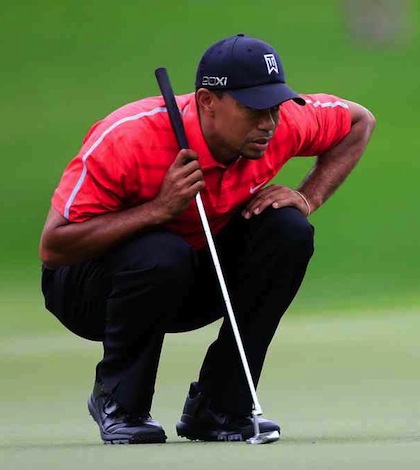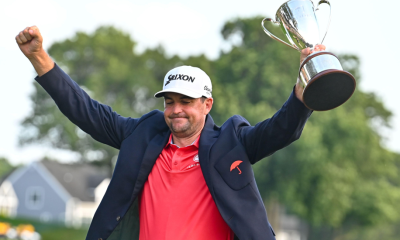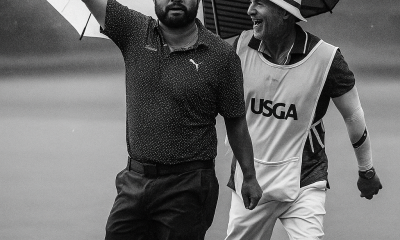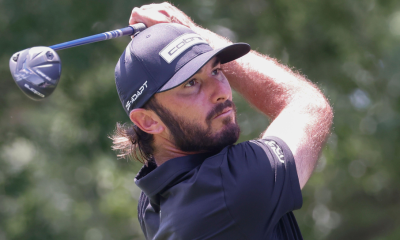Opinion & Analysis
The most important putts to make

Back in May, I felt that Tiger Woods was Statistically Primed For the U.S. Open.
Tiger had just come off his fourth victory for the year, and was using a very conservative tee shot strategy — hitting a lot of 3 woods and 5 woods off tees where most of his competitors were hitting driver.
All of the research I have conducted actually states that a conservative tee shot strategy is usually a bad idea, and that leaving the driver in the bag should be a golfer’s very last option, not his first or second option. But, my reasoning was that since Merion would force a lot of lay-up shots off the tee and that nobody was better at laying up off the tee than Tiger, he was in prime position to win his fourth U.S. Open.
However, there was something that made me a little uncomfortable about forecasting Tiger’s success for the U.S. Open. For most of the first half of the season he was by far and away the best putter on the PGA Tour from outside 15 feet. And all the research I have done has shown that Tour players will move toward the means on putts from outside 15 feet regardless of their putting skill level. I feel that this important information for amateurs to understand in order to not only putt better, but to better plan their shots.
The gold standard for putting metrics is Strokes Gained – Putting. The concept is simple: It calculates the distance of the putt and what the average number of putts for the field have been from that distance. Then it takes the number of putts the golfer makes and subtracts it from the field average.
For example, if a golfer two-putts from 40 feet and the field average from 40 feet for the tournament is at 2.183 strokes, then the golfer gained 0.183 strokes on the field from that particular distance of putt. If the golfer three-putts, then they lost -0.817 strokes to the field on that putt.
What I found was that the distance range of putts that correlates most strongly to Strokes Gained — Putting are putts from 3 to 15 feet. Here is the list of the current top-15 golfers in Strokes Gained — Putting and how they rank on putts from various distances.
The table shows that not only do these top putters tend to rank much better on putts from 3 to 15 feet than on putts longer than 15 feet, but the standard deviation shows much more variance in the rankings as the putts get longer. Sergio Garcia is ranked No. 1 in putts from more than 25 feet and in Strokes — Gained Putting. However, this is merely an anomaly and goes to show how there is little rhyme or reason as to what golfers will make putts from longer than 15 feet.
Here’s a line chart that hopefully illustrates the point a little better.
I call the percentage of putts made from longer than 15 feet a “volatile metric.” What I mean is that a player may rank high in putts made from greater than 15 feet one season, and then rank low on putts made from greater than 15 feet the very next season. It does not matter if the golfer is generally a “great putter” or a “bad putter.”
Here’s a few examples using typically “great putters” (Baddeley, Donald and Snedeker) versus typically “bad putters” (Weekley, Garrigus and Stadler) on putts from longer than 15 feet over the years.
The table further demonstrates the volatility on making putts from longer than 15 feet. Luke Donald has been the greatest putter on Tour during the past five years, and he has had some years where he has made a high percentage of putts from longer than 15 feet and other years where he has struggled from this distance. Conversely, Boo Weekley has been one of the worst putters on Tour in the past five years and he has had some years where he has made a lot of long putts and in other years he has struggled from longer distances.
The data shows that making putts from outside 15 feet has more to do with luck, while making putts from inside 15 has more to do with skill. Thus, for golfers looking to learn from this, they should spend more of their time practicing putts from 3 to 15 feet than putts longer than 15 feet.
However, if I want to go into more finite detail, the strongest correlation of putts made from a one-foot distance range and putts gained is putts from 3 to 4 feet. This is particularly telling when we look at the rankings of the top and bottom-15 players in Strokes Gained — Putting and their rankings in putts from 3 and 4 feet.
I believe that the reason for the strong correlation on these 3- to 4-foot putts and Strokes Gained — Putting is because a putt from 3 to 4 feet is very makeable, but just difficult enough where golfers can easily miss. I believe that these putts require the basic fundamentals to good putting in the golfer’s ability to aim properly, the centeredness of contact and having the right amount of touch and speed on the putt. I also feel it requires a sharp eye for green reading.
While most putts from 3 to 4 feet have little or no break to them, the golfer has to correctly identify that small break when it is there. And again, we should note that Sergio (and Tiger) are mere anomalies as the average ranking for these top-15 putters from 3 to 4 feet is typically in the top-50.
Thus, I recommend golfers not only focus their practice toward putts from inside 15 feet, but to spend a little extra time on those 3 to 4 footers in order to get the fundamentals of putting.
But, that’s not all that the data shows. Another key metric is that current average on Tour is for a golfer to make one birdie putt from outside 15 feet for every 36.2 holes of golf he plays. In essence, it will take a little over two rounds before the average Tour player will make a birdie putt longer than 15 feet.
Thus, if golfers want to make more birdies, they need to strive to get more birdie putts inside 15 feet rather than hope that they can make a few long putts outside of 15 feet. This is what happens in EVERY super-low round on Tour. The player simply accumulates a lot of birdie opportunities. For instance, Tiger’s 61 at Firestone included nine birdie opportunities from inside 15 feet in which Tiger converted eight of them.
For golfers looking to shoot better scores by improving their putting, focus on making more putts from inside 15 feet. And if you’re looking to make substantial improvements to your score, accumulate more birdie opportunities inside 15 feet. For the higher handicappers, I suggest continuing to work on putting from inside 15 feet and to try to accumulate more par opportunities from inside 15 feet.
Opinion & Analysis
The 2 primary challenges golf equipment companies face

As the editor-in-chief of this website and an observer of the GolfWRX forums and other online golf equipment discourse for over a decade, I’m pretty well attuned to the grunts and grumbles of a significant portion of the golf equipment purchasing spectrum. And before you accuse me of lording above all in some digital ivory tower, I’d like to offer that I worked at golf courses (public and private) for years prior to picking up my pen, so I’m well-versed in the non-degenerate golf equipment consumers out there. I touched (green)grass (retail)!
Complaints about the ills of and related to the OEMs usually follow some version of: Product cycles are too short for real innovation, tour equipment isn’t the same as retail (which is largely not true, by the way), too much is invested in marketing and not enough in R&D, top staffer X hasn’t even put the new driver in play, so it’s obviously not superior to the previous generation, prices are too high, and on and on.
Without digging into the merits of any of these claims, which I believe are mostly red herrings, I’d like to bring into view of our rangefinder what I believe to be the two primary difficulties golf equipment companies face.
One: As Terry Koehler, back when he was the CEO of Ben Hogan, told me at the time of the Ft Worth irons launch, if you can’t regularly hit the golf ball in a coin-sized area in the middle of the face, there’s not a ton that iron technology can do for you. Now, this is less true now with respect to irons than when he said it, and is less and less true by degrees as the clubs get larger (utilities, fairways, hybrids, drivers), but there remains a great deal of golf equipment truth in that statement. Think about it — which is to say, in TL;DR fashion, get lessons from a qualified instructor who will teach you about the fundamentals of repeatable impact and how the golf swing works, not just offer band-aid fixes. If you can’t repeatably deliver the golf club to the golf ball in something resembling the manner it was designed for, how can you expect to be getting the most out of the club — put another way, the maximum value from your investment?
Similarly, game improvement equipment can only improve your game if you game it. In other words, get fit for the clubs you ought to be playing rather than filling the bag with the ones you wish you could hit or used to be able to hit. Of course, don’t do this if you don’t care about performance and just want to hit a forged blade while playing off an 18 handicap. That’s absolutely fine. There were plenty of members in clubs back in the day playing Hogan Apex or Mizuno MP-32 irons who had no business doing so from a ballstriking standpoint, but they enjoyed their look, feel, and complementary qualities to their Gatsby hats and cashmere sweaters. Do what brings you a measure of joy in this maddening game.
Now, the second issue. This is not a plea for non-conforming equipment; rather, it is a statement of fact. USGA/R&A limits on every facet of golf equipment are detrimental to golf equipment manufacturers. Sure, you know this, but do you think about it as it applies to almost every element of equipment? A 500cc driver would be inherently more forgiving than a 460cc, as one with a COR measurement in excess of 0.83. 50-inch shafts. Box grooves. And on and on.
Would fewer regulations be objectively bad for the game? Would this erode its soul? Fortunately, that’s beside the point of this exercise, which is merely to point out the facts. The fact, in this case, is that equipment restrictions and regulations are the slaughterbench of an abundance of innovation in the golf equipment space. Is this for the best? Well, now I’ve asked the question twice and might as well give a partial response, I guess my answer to that would be, “It depends on what type of golf you’re playing and who you’re playing it with.”
For my part, I don’t mind embarrassing myself with vintage blades and persimmons chasing after the quasi-spiritual elevation of a well-struck shot, but that’s just me. Plenty of folks don’t give a damn if their grooves are conforming. Plenty of folks think the folks in Liberty Corner ought to add a prison to the museum for such offences. And those are just a few of the considerations for the amateur game — which doesn’t get inside the gallery ropes of the pro game…
Different strokes in the game of golf, in my humble opinion.
Anyway, I believe equipment company engineers are genuinely trying to build better equipment year over year. The marketing departments are trying to find ways to make this equipment appeal to the broadest segment of the golf market possible. All of this against (1) the backdrop of — at least for now — firm product cycles. And golfers who, with their ~15 average handicap (men), for the most part, are not striping the golf ball like Tiger in his prime and seem to have less and less time year over year to practice and improve. (2) Regulations that massively restrict what they’re able to do…
That’s the landscape as I see it and the real headwinds for golf equipment companies. No doubt, there’s more I haven’t considered, but I think the previous is a better — and better faith — point of departure when formulating any serious commentary on the golf equipment world than some of the more cynical and conspiratorial takes I hear.
Agree? Disagree? Think I’m worthy of an Adam Hadwin-esque security guard tackle? Let me know in the comments.
@golfoncbs The infamous Adam Hadwin tackle ? #golf #fyp #canada #pgatour #adamhadwin ? Ghibli-style nostalgic waltz – MaSssuguMusic
Podcasts
Fore Love of Golf: Introducing a new club concept

Episode #16 brings us Cliff McKinney. Cliff is the founder of Old Charlie Golf Club, a new club, and concept, to be built in the Florida panhandle. The model is quite interesting and aims to make great, private golf more affordable. We hope you enjoy the show!
Opinion & Analysis
On Scottie Scheffler wondering ‘What’s the point of winning?’

Last week, I came across a reel from BBC Sport on Instagram featuring Scottie Scheffler speaking to the media ahead of The Open at Royal Portrush. In it, he shared that he often wonders what the point is of wanting to win tournaments so badly — especially when he knows, deep down, that it doesn’t lead to a truly fulfilling life.
View this post on Instagram
“Is it great to be able to win tournaments and to accomplish the things I have in the game of golf? Yeah, it brings tears to my eyes just to think about it because I’ve literally worked my entire life to be good at this sport,” Scheffler said. “To have that kind of sense of accomplishment, I think, is a pretty cool feeling. To get to live out your dreams is very special, but at the end of the day, I’m not out here to inspire the next generation of golfers. I’m not out here to inspire someone to be the best player in the world, because what’s the point?”
Ironically — or perhaps perfectly — he went on to win the claret jug.
That question — what’s the point of winning? — cuts straight to the heart of the human journey.
As someone who’s spent over two decades in the trenches of professional golf, and in deep study of the mental, emotional, and spiritual dimensions of the game, I see Scottie’s inner conflict as a sign of soul evolution in motion.
I came to golf late. I wasn’t a junior standout or college All-American. At 27, I left a steady corporate job to see if I could be on the PGA Tour starting as a 14-handicap, average-length hitter. Over the years, my journey has been defined less by trophies and more by the relentless effort to navigate the deeply inequitable and gated system of professional golf — an effort that ultimately turned inward and helped me evolve as both a golfer and a person.
One perspective that helped me make sense of this inner dissonance around competition and our culture’s tendency to overvalue winning is the idea of soul evolution.
The University of Virginia’s Division of Perceptual Studies has done extensive research on reincarnation, and Netflix’s Surviving Death (Episode 6) explores the topic, too. Whether you take it literally or metaphorically, the idea that we’re on a long arc of growth — from beginner to sage elder — offers a profound perspective.
If you accept the premise literally, then terms like “young soul” and “old soul” start to hold meaning. However, even if we set the word “soul” aside, it’s easy to see that different levels of life experience produce different worldviews.
Newer souls — or people in earlier stages of their development — may be curious and kind but still lack discernment or depth. There is a naivety, and they don’t yet question as deeply, tending to see things in black and white, partly because certainty feels safer than confronting the unknown.
As we gain more experience, we begin to experiment. We test limits. We chase extreme external goals — sometimes at the expense of health, relationships, or inner peace — still operating from hunger, ambition, and the fragility of the ego.
It’s a necessary stage, but often a turbulent and unfulfilling one.
David Duval fell off the map after reaching World No. 1. Bubba Watson had his own “Is this it?” moment with his caddie, Ted Scott, after winning the Masters.
In Aaron Rodgers: Enigma, reflecting on his 2011 Super Bowl win, Rodgers said:
“Now I’ve accomplished the only thing that I really, really wanted to do in my life. Now what? I was like, ‘Did I aim at the wrong thing? Did I spend too much time thinking about stuff that ultimately doesn’t give you true happiness?’”
Jim Carrey once said, “I think everybody should get rich and famous and do everything they ever dreamed of so they can see that it’s not the answer.”
Eventually, though, something shifts.
We begin to see in shades of gray. Winning, dominating, accumulating—these pursuits lose their shine. The rewards feel more fleeting. Living in a constant state of fight-or-flight makes us feel alive, yes, but not happy and joyful.
Compassion begins to replace ambition. Love, presence, and gratitude become more fulfilling than status, profits, or trophies. We crave balance over burnout. Collaboration over competition. Meaning over metrics.
Interestingly, if we zoom out, we can apply this same model to nations and cultures. Countries, like people, have a collective “soul stage” made up of the individuals within them.
Take the United States, for example. I’d place it as a mid-level soul: highly competitive and deeply driven, but still learning emotional maturity. Still uncomfortable with nuance. Still believing that more is always better. Despite its global wins, the U.S. currently ranks just 23rd in happiness (as of 2025). You might liken it to a gifted teenager—bold, eager, and ambitious, but angsty and still figuring out how to live well and in balance. As much as a parent wants to protect their child, sometimes the child has to make their own mistakes to truly grow.
So when Scottie Scheffler wonders what the point of winning is, I don’t see someone losing strength.
I see someone evolving.
He’s beginning to look beyond the leaderboard. Beyond metrics of success that carry a lower vibration. And yet, in a poetic twist, Scheffler did go on to win The Open. But that only reinforces the point: even at the pinnacle, the question remains. And if more of us in the golf and sports world — and in U.S. culture at large — started asking similar questions, we might discover that the more meaningful trophy isn’t about accumulating or beating others at all costs.
It’s about awakening and evolving to something more than winning could ever promise.



























td
Aug 17, 2013 at 10:37 am
…” I believe that these putts require the basic fundamentals to good putting in the golfer’s ability to aim properly, the centeredness of contact and having the right amount of touch and speed on the putt. I also feel it requires a sharp eye for green reading.”
Is that you Tim Mccarver!?!?
t120
Aug 20, 2013 at 1:37 am
…funniest baseball comment in a non-baseball thread I’ve ever read.
Tim
Aug 17, 2013 at 7:25 am
Great analysis! I really appreciate the data crunching you did to support your recommendations. I look forward to reading more and to getting the e-book.
Bob
Aug 16, 2013 at 4:50 pm
Sooooo hit the ball closer to the hole and make more putts? Who woooda thunk it!
Richie Hunt
Aug 22, 2013 at 1:34 pm
Bob,
That wasn’t the point of the article. The point is that the *most important putts to make* are putts from inside 15 feet. Mainly because making putts from longer than 15 feet come down to luck and randomness, regardless of your putting skill. Obviously, we will make less putts as we get further away from the hole, but the best putters that ‘gain the most strokes’ on the greens do it by making more putts inside 15 feet than their competition.
steff
Aug 16, 2013 at 4:15 am
Great article Rich! I did not agree with your last article but this is spot on!
This year i have improoved my putting a lot. I´ve practiced a lot from 4 feet. I have a drill where i putt 8 tees around the hole and putt 4 balls from each tee. I do this before evry competative round. I´ve gone from 25/32 to around 30 evry time!
This have resulted in lowering my average score a lot but not lowered my best scores (yet).
Next up is 6-7 feet. With the same drill i usuly score around 15-20 out of 32.
Pat
Aug 15, 2013 at 7:13 pm
All I learned from this is that if Luke Donald could make something outside 15 feet he’d be pretty good.
Richie Hunt
Aug 16, 2013 at 9:06 am
Well, he’s pretty good to start with. It just means that Luke is likely to progress towards the mean from outside 15 feet pretty soon. Luke’s biggest weakness is his driving. And lately he has struggled on some of his longer approach shots.
Steve
Aug 15, 2013 at 7:07 pm
Where do you access all of your source data? I’d be very interested in rooting through the data.
Thanks,
Rich Hunt
Aug 15, 2013 at 3:00 pm
Geoff,
The research I’ve done is based on years of work. I just used this year’s current data as an example. Generally 5-10 foot putts are about as important as 10-15 footers. This year there is a bit of an exception as the top players in Putts Gained are putting quite well from 5-10 feet. However, I expect that to regress more towards the 10-15 footers.
I generally recommend golfers that are struggling to work on 3-4 footers first. Then move to 5-10 footers. Then 10-15 footers.
Hope this helps.
Geoff S
Aug 15, 2013 at 2:45 pm
Maybe I’m missing something here, but the 10-15′ foot putts don’t appear to be as important as < 10' putts. The 5-10' ranks of the top putters is pretty impressive.
I agree on your thesis though. Without question the more practice I put into 5'-15' putts, the better my scores get each round.